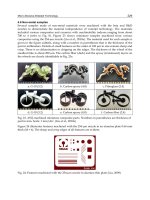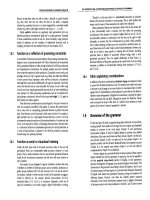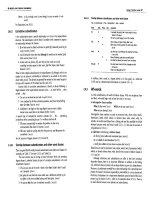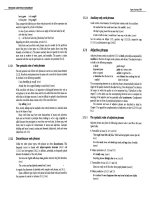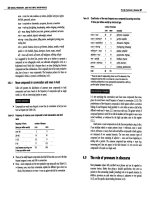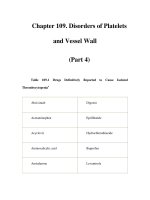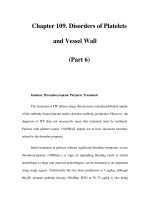Medical Management of Diabetes and Heart Disease - part 10 potx
Bạn đang xem bản rút gọn của tài liệu. Xem và tải ngay bản đầy đủ của tài liệu tại đây (452.05 KB, 26 trang )
Nonpharmacological Risk Reduction 269
9. Improved quality of life and self-esteem, and reduced psychological
stress.
The primary side effect of acute exercise is hypoglycemia. Patients require
specific guidelines either to increase carbohydrate consumption or to decrease
medication based on the intensity of exercise and relationship of the planned
exercise to the timing of the next meal. For those attempting to lose weight,
medication adjustment is chosen over adding extra calories. For some, exercise
after a meal without medication adjustment is preferred. Postexercise, late-onset
hypoglycemia (PEL) occurs several hours following an exercise session and is
a significant concern for those treated with insulin or insulin secretagogues. Post-
exercise late-onset hypoglycemia can be the result of acutely increased insulin
mobilization and sensitivity, increased glucose utilization, replenishment of gly-
cogen stores, and defective counterregulatory mechanisms. Patients need to learn
how to prevent PEL by remembering to supplement carbohydrates during the
postexercise phase, to reduce the dose of insulin that peaks during the postexer-
cise phase, and to monitor blood glucose frequently.
The American Diabetes Association recommends a graded exercise test for
patients at high risk for underlying cardiovascular disease based on the following
criteria (16): age Ͼ35 years; type 2 diabetes of Ͼ10 years duration; type 1 diabe-
tes of Ͼ15 years duration; presence of any additional risk factor for coronary
artery disease; presence of microvascular disease (including microalbuminuria);
peripheral vascular disease; and autonomic neuropathy.
Rhythmic exercises with the use of the lower extremities, such as walking
or cycling, are safely recommended. Patients with established cardiovascular dis-
ease usually require supervision in a monitored cardiac rehabilitation program.
Unfortunately, little is known about how to increase or maintain participation in
exercise programs. Relapse is common and all health care providers play a role
in supporting patients in their efforts at exercise.
V. QUALITY OF LIFE AND OBSTACLES TO CARE
The delivery of diabetes care and education has undergone a paradigm shift from
giving advice and blaming the patient for failure to providing patients with the
choice of aggressive, individualized treatment and an education plan tailored to
their needs. This shift has melded health care providers and patients as partners
in managing a devastating disease. The demands for daily self-management of
diabetes are so formidable that each component of the diabetes education curricu-
lum includes discussion of the psychosocial needs of the patient. The embar-
rassment of hypoglycemia and resultant fear, the social aspects of eating and
dealing with well-meaning family members who comment on food choices, the
270 Peragallo-Dittko
sense of failure associated with elevated blood glucose readings despite a sincere
effort, and the frustrations of needing medication when self-image associates pill
taking with the sick role are a few examples of the psychosocial complexities.
Effective diabetes education begins with listening to the patient and his percep-
tion of life with diabetes.
Health care professionals can identify with patients who cannot manage to
follow every single diabetes management recommendation because we cannot
follow them either. Regardless of type of management, such as fee-for-service
or managed care, chart reviews suggest that only about 50% of patients are asked
to have their HbA1c measured even once a year, despite a recommendation for
screening every 6 months. An even smaller proportion of patients are being
screened on an annual basis for such complications as hyperlipidemia, retinopa-
thy, proteinuria, or foot pathology. The compelling evidence that tight control
of blood glucose, blood pressure, and lipids provides measurable improvement
in outcomes warrants new initiatives. For both patients and health professionals,
the opportunities and challenges are abundant.
REFERENCES
1. Bantle JP, Swanson JE, Thomas W, Laine DC. Metabolic effects of dietary sucrose
in type II diabetic subjects. Diabetes Care 1993;16:1301–1305.
2. Peterson DB, Lambert J, Gerring S, Darling P, Carter RD, Jelfs R, Mann JI. Sucrose
in the diet of diabetic patients—just another carbohydrate? Diabetologia 1986;29:
216–220.
3. Brownell KD, Wadden TA. Etiology and treatment of obesity: understanding a seri-
ous, prevalent, and refractory disorder. J Consult Clin Psychol 1992;60:505–517.
4. Foreyt JP. Issues in the assessment and treatment of obesity. J Consult Clin Psychol
1987;55:677–684.
5. Wing RR, Blair EH, Bononi P, Marcus MD, Watanabe R, Bergman RN. Caloric
restriction per se is a significant factor in improvements in glycemic control and
insulin sensitivity during weight loss in obese NIDDM patients. Diabetes Care 1994;
17:30–36.
6. Kelley DE, Wing R, Buonocore C. Sturis J, Polonsky K, Fitzsimmons M. Relative
effects of calorie restriction and weight loss in non-insulin-dependent diabetes melli-
tus. J Clin Endocrinol Metab 1993;77:1287–1293.
7. Wing RR, Koeske R, Epstein LH, Nowak MP, Gooding W, Becker D. Long-term
effects of modest weight loss in type II diabetic patients. Arch Intern Med 1987;
147:1749–1753.
8. Watts NB, Spanheimer RG, DiGirolamo M, Gebhart SS, Musey VC, Siddiq YK,
Phillips LS. Prediction of glucose response to weight loss in patients with non-
insulin-dependent diabetes mellitus. Arch Intern Med 1990;150:803–806.
9. Franz MJ, Horton ES Sr, Bantle JP, Beebe CA, Brunzell JD, Coulston AM, Henry
Nonpharmacological Risk Reduction 271
RR, Hoogwerf BJ, Stacpook PW. Nutrition principles for the management of diabe-
tes and related complications: a technical review. Diabetes Care 1994;17:490–518.
10. Rubin RR, Peyrot M, Saudek, CD. The effect of a diabetes education program incor-
porating coping skills training on emotional well-being and diabetes self-efficacy.
Diabetes Educ 1993;19:210–214.
11. Bastyr III EJ, Stuart CA, Brodows RG, Schwartz S, Graf CJ, Zagar A, Robertson
KE. Therapy focused on lowering postprandial glucose, not fasting glucose, may be
superior for lowering HbA1c. Diabetes Care 2000;23:1236–1241.
12. Haire-Joshu D, Glasgow RE, Tibbs, TL. Smoking and diabetes. Diabetes Care 1999;
22:1887–1898.
13. Eriksson KF, Lindgarde F. Prevention of type II diabetes mellitus by diet and physi-
cal exercise. The 6 year Malmo Feasibility Study. Diabetologia 1991;34:891–898.
14. Schneider SH, Khachadurian AK, Amorosa LF, Clemow L, Ruderman NB. Ten-
year experience with an exercise-based outpatient lifestyle modification program in
the treatment of diabetes mellitus. Diabetes Care 1992;15(suppl 4):1800–1810.
15. Vanninen E, Uusitupa M, Siitonen O, Laitinen J, Lansimies E. Habitual physical
activity, aerobic capacity, and metabolic control in patients with newly diagnosed
type II diabetes mellitus: effect of a 1-year diet and exercise intervention. Diabeto-
logia 1992;35:340–346.
16. American Diabetes Association. Diabetes mellitus and exercise. Diabetes Care 2000;
23:S50–S54.
17. Expert Panel on Detection, Evaluation, and Treatment of High Blood Cholesterol in
Adults. Executive summary of the third report of the National Cholesterol Education
Program (NCEP) expert panel on detection, evaluation, and treatment of high blood
cholesterol in adults (Adult Treatment Panel III). JAMA 2001; 285:2486–2497.
18. American Diabetes Association. Management of dyslipidemia in adults with diabe-
tes. Diabetes Care 2001;24:S58–S61.
19. Franz MJ, Kulkarni K, Daly AS, Gillespie SJ. In: Funnell MM, Hunt C, Kulkarni
K, Rubin RR, Yarborough PC, eds. A Core Curriculum for Diabetes Education, 3rd
ed. Chicago: American Association of Diabetes Educators, 1998:211.
16
Future Directions: Elucidation
of Mechanisms as Targets
for Therapy
David J. Schneider and Burton E. Sobel
University of Vermont, Burlington, Vermont
Optimal treatment of patients with diabetes requires an understanding of the
mechanisms underlying the disease. Treatment must be designed not only to con-
trol hyperglycemia but also to prevent or retard complications that result from
diverse processes underlying the development of diabetes. This chapter will focus
on the therapeutic promise of elucidation of such processes and their cardiovascu-
lar consequences.
All diabetic subjects exhibit hyperglycemia. Yet hyperglycemia is only the
tip of an iceberg of abnormalities in carbohydrate, lipid, and protein metabolism.
Although insulin deficiency is the hallmark of type 1 diabetes, 90% of diabetic
subjects suffer from type 2 diabetes, a disorder of dysinsulinemia. For decades
before its onset, insulin resistance and compensatory increases in the concentra-
tion of insulin and its precursors in blood are present, particularly postprandially.
Impaired glucose tolerance occurs eventually as compensatory mechanisms fail.
Early treatment may delay the onset of frank diabetes and prevent or retard the
development of cardiovascular complications.
Diabetes per se, independent of coexistent cardiovascular risk factors, ac-
celerates the progression of cardiovascular disease. In addition, diabetes acts
synergistically with other determinants of cardiac risk such as hypertension and
hyperlipidemia. The specific pathways involved must be identified to optimize
prevention of the resultant cardiovascular sequelae.
273
274 Schneider and Sobel
I. TREATMENT OF THE HORMONAL AND METABOLIC
ABNORMALITIES OF DIABETES
Control of hyperglycemia retards progression of microvascular disease in both
type 1 and type 2 diabetes. Accordingly, stringent glycemic control is imperative.
Yet glycemic control exerts only a modest impact in retarding progression of
macrovascular disease. Clearly other steps are needed.
The recently initiated BARI 2D trial has been designed to provide informa-
tion useful in this regard. Patients are being assigned randomly to stringent and
comparable glycemic control with regimens that are either insulin-sensitizing (fo-
cusing on glitazones and metformin) or inulin-providing (focusing on insulin and
sulfonylureas) regimens. Thus, the potential value of reduction of insulin resis-
tance is being assessed. The effects of the two approaches on activation of coagu-
lation, platelets, and fibrinolysis will be clarified as well.
Because patients with type 2 diabetes are insulin-resistant, provision of
exogenous insulin may be the most successful means for providing an adequate
supply of substrate for energy in injured cells. By contrast, provision of additional
insulin may have potentially deleterious effects such as promoting thrombosis.
The provision of insulin may increase the potential for thrombin generation, in-
creased reactivity of platelets, and decrease the fibrinolytic response. In combina-
tion, these effects may exacerbate thrombosis, predispose to reocclusion of in-
farct-related vessels, and delay resolution of thrombotic occlusion. Accordingly,
treatment with insulin in the setting of acute myocardial infarction may entail
risk. In addition, induction of hypoglycemic episodes may be particularly delete-
rious in association with myocardial ischemia. Thus, further study is needed to
determine the nature of optimal metabolic control and the method by which it
can best be achieved.
Nevertheless, results in the DIGAMI study demonstrated that stringent gly-
cemic control at the time of occurrence of acute myocardial infarction reduces
the incidence of subsequent cardiac events. The improved outcome is consistent
with previously demonstrated beneficial effects of infusion of glucose, insulin,
and potassium in nondiabetic subjects who sustain an acute myocardial infarction.
II. ATHEROGENESIS IN DIABETES
The traditional concept that atherogenesis is an orderly process of progressive
luminal encroachment leading ultimately to occlusion has been refined. Both
plaque evolution and occlusion of vessels often reflect precipitous and often re-
peated rupture of vulnerable atherosclerotic plaques. Thus, rupture of vulnerable
plaques is the most common proximate cause of acute coronary syndromes. Such
plaques are characterized by a high lipid content, a thin, relatively acellular cap,
a paucity of vascular smooth muscle cells, and inflammatory cells, particularly
Future Directions 275
macrophages, in the shoulder regions. The substrate for plaque rupture is a lipid-
laden, often necrotic core with an overlying acellular fibrous cap. Initiators of
rupture can be intrinsic to the plaque, such as activation of matrix metallopro-
teinases by macrophages in the shoulder region, or extrinsic, such as high shear
forces exerted by nonlaminar flow of blood. Diabetes accelerates evolution of
vulnerable plaques. How it does so is being explored vigorously so that novel
and effective prophylactic and therapeutic targets can be identified.
Diabetic subjects (regardless of symptoms) should be treated to lower LDL
cholesterol below 100 mg/dL to reduce the evolution of vulnerable plaques. Be-
cause diabetes is associated with increased small dense LDL and oxidized LDL,
each atherogenic treatment should be designed to reduce their concentrations.
Paradoxically, migration of smooth muscle cells into the neointima may
protect against plaque vulnerability. Thus, increased cellularity of the cap region
appears to reduce the risk of plaque rupture. Cell surface proteolysis mediated
by plasminogen activators (urokinase type and tissue type) is critical in migration.
Accordingly, the balance between plasminogen activators and their primary in-
hibitor, plasminogen activator inhibitor type-1 (PAI-1), is likely to be one deter-
minant of neointimal cellularity. Patients with diabetes have increased concentra-
tions of PAI-1 in blood and in vessel walls. Modulation of expression of these
proteins is likely to become a target for treatment.
Inflammation, reflected by markers in blood such as C-reactive protein, is
increased in subjects predisposed to plaque rupture. Diabetes appears to intensify
inflammation and the deleterious effects of inflammation. Elucidation of interac-
tions between diabetes and inflammation should lead to novel treatment strategies
to prevent or retard coronary atherogenesis sequelae such as acute coronary syn-
dromes precipitated by plaque rupture.
The prevalence of hypertension in diabetic subjects is high. This condition
increases external mechanical forces on vulnerable plaques and promotes plaque
rupture or erosion. Altered flow attributable to atherosclerotic plaque contributes.
The association between hypertension and plaque rupture underlies the need for
aggressive control of blood pressure (to a target of less than 130/85). Even more
aggressive control may be beneficial in reducing the incidence of cardiac events.
Therapy with ACE inhibitors and/or angiotensin-1 receptor blockers may be par-
ticularly useful because of its nephroprotective effects. In addition, it may nor-
malize deranged fibrinolysis attributable to angiotensin-dependent synthesis of
PAI-1.
III. ATHEROGENESIS IN THE PREDIABETIC STATE
The 15% incidence of cardiac death in the first 10 years after the diagnosis of
diabetes emphasizes the profound acceleration of progression of atherosclerosis
that occurs long before diabetes becomes overt. The prediabetic state provides
276 Schneider and Sobel
particularly fertile ground for germination of vulnerable plaques. Thus, a focus
on treatment in the prediabetic state is likely to be important in preventing cardio-
vascular events later in ultimately diabetic subjects. One example is women with
the polycystic ovary syndrome. These subjects are insulin-resistant and often have
postprandial hyperglycemia. They are also often hypertensive. They are at in-
creased risk for coronary artery disease. Accordingly, therapy designed to amelio-
rate insulin resistance is under intense investigation.
IV. THROMBOSIS COMPLICATING PLAQUE RUPTURE
Diabetes increases the risk of thrombosis complicating plaque rupture. Accord-
ingly, diabetic compared with nondiabetic subjects are more likely to be the vic-
tims of acute coronary syndromes including myocardial infarction and unstable
angina and of sudden cardiac death secondary to thrombosis in response to plaque
rupture. Exaggerated thrombosis can predispose to recurrent events and to accel-
erated progression of atherosclerosis. Accordingly, mechanisms of prothrombosis
must be delineated and their therapeutic implications exploited.
Diabetes exerts complex and diverse effects leading to activation of coagu-
lation. Thrombin generation and activity are increased, platelets are primed, and
the fibrinolytic response is impaired because of increased expression of PAI-1.
The causes are attributable to both hormonal and metabolic abnormalities char-
acteristic of diabetes. Accordingly, optimal treatment of diabetes that achieves
metabolic control and normalizes the hormonal abnormalities should attenuate
the prothrombotic state.
In the BARI 1 study, percutaneous coronary intervention in patients with
diabetes was found to be followed by increased cardiac mortality over 5 years.
One mechanism contributing to the negative outcome may have been the exagger-
ated thrombotic response to vessel injury. Results in subsequent studies have
shown that treatment with powerful antiplatelet agents (glycoprotein IIb-IIIa in-
hibitors) reduces the incidence of complications after coronary intervention and
in patients with acute coronary syndromes. Beneficial effects are particularly pro-
nounced in diabetic subjects. A reduction in mortality 6 months after coronary
intervention is evident in diabetic subjects treated with abciximab during the
procedure. Treatment with tiroliban of patients with acute coronary syndromes
reduces markedly their risk of complications over the next 30 days.
V. CARDIOMYOPATHY AND DIABETES
Induction of cardiomyopathic changes in hearts of animals rendered insulin defi-
cient is a well-recognized phenomenon. Accordingly, the term ‘‘diabetic cardio-
Future Directions 277
myopathy’’ has been extant for decades. Implicated derangements include im-
paired function of the sarcoplasmic reticulum, an organelle responsible for the
uptake and release of intracellular calcium and, therefore, pivotal in modulating
cardiac contractility. However, cardiomyopathy changes may not be related ex-
clusively to metabolic derangements typical of insulin deficiency. They occur
also in hearts of patients with type 2 diabetes whose hyperglycemia is well con-
trolled.
Abnormalities in myocardial ultrasonic backscatter are seen in diabetic sub-
jects even when ventricular systolic and diastolic function are normal. Such
changes have been attributed to intramyocardial edema, alterations in the nature
and deposition of collagen, and accumulation of advanced glycation products.
Patients with diabetes who sustain acute myocardial infarction exhibit
greater impairment in ventricular function and more severe congestive heart fail-
ure normalized for infarct size than do nondiabetic subjects. Factors implicated
in causing such derangements include limitation of energy supply attributable to
insulin resistance in the myocardium and diminished availability of intracellular
glucose and its metabolites for oxidative phosphorylation, impaired calcium cy-
cling associated with abnormalities in the sarcoplasmic reticulum calcium-
sensitive ATPase, and contributions of advanced glycation end products to cross-
linking structural proteins and augmenting myocardial stiffness.
Elucidation of specific mechanisms responsible for cardiomyopathic
changes associated with diabetes should enhance prevention and treatment of
ventricular functional impairment under basal conditions and in response to myo-
cardial insults.
VI. SUMMARY
A worldwide epidemic of diabetes is in progress. In the United States alone,
over 16 million subjects have the disease. Many more are insulin-resistant. The
progression of cardiovascular disease is accelerated by diabetes itself and by its
interactions with other determinants of cardiac risk. Further elucidation of mecha-
nisms responsible will undoubtedly lead to improved treatment designed to di-
minish the progression of cardiovascular disease that is all too prominent in dia-
betes.
SUGGESTED READING
1. Bucala R, Makita Z, Zoschinsky T, Cerami A, Vlassara H. Lipid advanced glyco-
sylation: pathway for lipid oxidation in vivo. Proc Natl Acad Sci USA 1993; 90:
6434–6438.
278 Schneider and Sobel
2. Carmeliet P, Moons L, Lijnen R, et al. Inhibitory role of plasminogen activator
inhibitor-1 in arterial wound healing and neointimal formation. A gene targeting and
gene transfer study in mice. Circulation 1997; 96:3180–3191.
3. Davies MJ, Woolf N, Katz DR. The role of endothelial denudation injury, plaque
fissuring and thrombosis in the progression of human atherosclerosis. Atheroscler
Rev 1991; 23:105–113.
4. Davies MJ, Richardson PD, Woolf N, Kratz DR, Mann J. Risk of thrombosis in
human atherosclerotic plaques: Role of extracellular lipid, macrophage, and smooth
muscle content. Br Heart J 1993; 69:377–381.
5. Ehrmann DA, Schneider DJ, Sobel BE, Cavaghan MK, Imperial J, Rosenfield RL,
Polonsky KS. Troglitazone improves defects in insulin action, insulin secretion,
ovarian steroidogenesis, and fibrinolysis in women with polycystic ovary syndrome.
J Clin Endocrinol Metab 1997; 82:2108–2116.
6. Fontbonne A, Tchobroutsky G, Eschwege E, Richard JL, Claude JR, Rosselin GE.
Coronary heart disease mortality risk: Plasma insulin level is a more sensitive marker
than hypertension or abnormal glucose tolerance in overweight males. The Paris
prospective study. Int J Obes 1988; 12:557–565.
7. Haffner SM, Lehto S, Ronnemaa T, et al.: Mortality from coronary heart disease in
subjects with type 2 diabetes and in non-diabetic subjects with and without prior
myocardial infarction. N Engl J Med 1998; 339:229–234.
8. Jaffe AS, Spadaro JJ, Schechtman K, Roberts R, Geltman EM, Sobel E. Increased
congestive heart failure after myocardial infarction of modest extent in patients with
diabetes mellitus. Am Heart J 1984; 108:31–37.
9. Kabbani SS, Watkins MW, Ashikaga T, Terrien EF, Holoch PA., Sobel BE, Schnei-
der DJ. Platelet reactivity characterized prospectively: A determinant of outcome
90 days after percutaneous coronary intervention. Circulation 2001; 104:181–186.
10. Kruszynska Y, Yu JG, Sobel BE, Olefsky JM. Effects of troglitazone on blood con-
centrations of plasminogen activator inhibitor 1 in patients with type 2 diabetes mel-
litus and in lean and obese normal subjects. Diabetes 2000; 49:633–639.
11. LeWinter MM. Diabetic cardiomyopathy: An overview. Coron Artery Dis 1996; 7:
95–98.
12. Malmberg K, Norhammar A, Wedel II, Ryden L. Glucometabolic state at admission:
Important risk market of mortality in conventionally treated patients with diabetes
mellitus and acute myocardial infarction. Long-term results from the Diabetes and
Insulin-Glucose Infusion in Acute Myocardial Infarction Study. Circulation 1999;
99:2626–2632.
13. Perez JE, McGill JB, Santiago JV, Schechtman KB, Waggoner AD, Miller JG, Sobel
BE. Abnormal myocardial acoustic properties in diabetic patients and their correla-
tion with the severity of disease. J Am Coll Cardiol 1992; 19:1154–1162.
14. Schneider DJ, Sobel BE. Synergistic augmentation of expression of plasminogen
activator inhibitor type-1 induced by insulin, very-low-density lipoproteins, and fatty
acids. Coron Artery Dis 1996; 7:813–817.
15. Sobel BE. The potential influence of insulin and plasminogen activator inhibitor
type-1 on formulation of vulnerable atherosclerotic plaques associated with type 2
diabetes. Proc Assoc Am Physicians 1999; 111:313–318.
16. Sobel BE. Acceleration of restenosis by diabetes: Pathogenetic implications. Circu-
lation 2001; 103:1165–1187.
Future Directions 279
17. Sobel BE, Woodcock-Mitchell J, Schneider DJ, Holt RE, Marutsuka K, Gold H.
Increased plasminogen activator inhibitor type-1 in coronary artery atherectomy
specimens from type 2 diabetic compared with nondiabetic patients: A potential
factor predisposing to thrombosis and its persistence. Circulation 1998; 97:2213–
2221.
18. The Diabetes Control and Complications Trial Research Group. The effect of inten-
sive treatment of diabetes on the development and progression of long-term compli-
cations in insulin-dependent diabetes mellitus. N Engl J Med 1993; 329:977–986.
19. The BARI Investigators. Influence of diabetes on 5-year mortality and morbidity in
a randomized trial comparing CABG and PTCA in patients with multivessel disease.
The Bypass Angioplasty Revascularization Investigation (BARI). Circulation 1997;
96:1761–1769.
20. UK Prospective Diabetes Study (UKPDS) Group. Effect of intensive blood-glucose
control with metformin on complications in over-weight patients with type 2 diabetes
(UKPDS 34). Lancet 1998; 352:854–865.
21. UK Prospective Diabetes Study (UKPDS) Group. Intensive blood glucose control
with sulphonylureas or insulin compared with conventional treatment and risk of
complications in patients with type 2 diabetes (UKPDS 33). Lancet 1998; 352:837–
853.
22. Warram JH, Martin BC, Krolewski AS, Soeldner JS, Kahn CR. Slow glucose re-
moval rate and hyperinsulinemia precede the development of type II diabetes in the
offspring of diabetic parents. Ann Intern Med 1990; 113:909–915.
About the Editors
BURTON E. SOBEL is Amidon Professor and Chair of the Department of
Medicine and Professor of Biochemistry at the University of Vermont College
of Medicine and Physician-in-Chief, Fletcher Allen Health Care, Burlington, Ver-
mont. The editor of Medical Management of Heart Disease (Marcel Dekker, Inc.)
and the author or coauthor of over 820 publications, he has lectured at universities
and conferences throughout the world. He is a member of the Royal Society of
Medicine, the American Heart Association, and the American College of Cardiol-
ogy. He received the A.B. degree (1958) from Cornell University, Ithaca, New
York, and the M.D. degree (1962) magna cum laude from Harvard Medical
School, Boston, Massachusetts.
DAVID J. SCHNEIDER is Associate Professor of Medicine and Director of the
Vascular Biology Unit at the University of Vermont College of Medicine, Burl-
ington, Vermont. He is the author or coauthor of more than 50 publications and
a Fellow of the American Heart Association and the American College of Cardi-
ology. Dr. Schneider obtained the B.A. degree (1982) magna cum laude from
the University of Notre Dame, Indiana, and the M.D. degree (1986) from the
University of Cincinnati College of Medicine, Ohio.
281
Index
ABCD, 72
ABCD-2V, 74
Abciximab, 114, 200
myocardial revascularization, 247–
248
ACE, 68, 70
ACE inhibitors (see Angiotensin con-
verting enzyme (ACE) inhibi-
tors)
Acetyl CoA carboxylase, insulin, 2
ACIP, 165
Acromegaly, 43
Acute coronary syndromes, 105–108,
193
myocardial revascularization, 236–
237
Adiposity, subcutaneous vs. visceral, 19
AFCAPS, 182
African-Americans, 51
Afro-Caribbeans, 23
Age, cardiovascular disease,
type 1 diabetes, 11–19
Air Force/Texas Coronary Atherosclero-
sis Prevention Study (AFCAPS),
182
ALLHAT, 74–75
Alpha-adrenergic blockers, hyperten-
sion, 76
Alpha glucosidase inhibitors, 6
American Diabetes Association, classifi-
cation system, 141
Amlodipine, 73
Angioplasty, vs. CABG, 201–202
Angiotensin-converting enzyme (ACE),
68, 70
Angiotensin-converting enzyme (ACE)
inhibitors, 6, 71, 157
CAD, 194–195
CHF, 220–221
hypertension, 76
type 2 diabetes, 114
Angiotensin II, 49–50, 52, 70
Angiotensin receptor blockers (ARBs),
CHF, 223
hypertension, 76
Anticoagulants,
CHF, 223
type 2 diabetes, 113–114
Antihypertensive and Lipid Lowering
Treatment to Prevent Heart At-
tack Trial (ALLHAT), 74–75
Antihypertensives, 74
Anti-insulin antibodies, 43
Antiplatelet Trialists’ Collaborative
Group, 192
Apo A-1, 124
Apo B, 86
Apo C-II, 88
Apo C-III, 88
Apo E, 88, 89
Apolipoprotein, 86
characteristics, 87
Apolipoprotein A-1 (apo A-1), 124
Apolipoprotein B (apo B), 86
282 Index
Apolipoprotein C-11 (apo C-II), 88
Apolipoprotein C-III (apo C-III), 88
Apolipoprotein E (apo E), 88, 89
Appropriate Blood Pressure Control in
Diabetes (ABCD), 72
Appropriate Blood Pressure Control in
Diabetes—Part 2 with Valsartan
(ABCD-2V), 74
ARBs,
CHF, 223
hypertension, 76
Arrhythmia, 171
Arterial Revascularization Therapy
Study (ARTS), 244
ARTS, 244
ASCVD, 86–87
pathophysiology, 86–87
Aspirin, 194
CAD, 192
PCOS, 157
type 2 diabetes, 113
Asymptomatic Cardiac Ischemia Pilot
(ACIP), 165
Asymptomatic diabetic,
left ventricular function abnormali-
ties, 167
myocardial revascularization, 233–
236
stress testing, 165
Atherogenesis,
prediabetic, future, 275–276
treatment, future, 274–275
Atherosclerosis, 105–108
diagnosis, 164–166
epidemiology, 179
insulin resistance syndrome, 50–51
prevention, 25–26
risk factors, 14
Atherosclerotic cardiovascular disease
(ASCVD), 86–87
pathophysiology, 86–87
Atorvastatin, 99
Balloon angioplasty, 233–239
vs. CABG, 239–242
CAD, 195–197
BARI, 196, 201–202, 232–233
BARI 2D, 4, 109, 195, 197–198
Beta blockers, 71, 74
CAD, 193–194
CHF, 221–222
hypertension, 76
myocardial revascularization, 251
Beta cells, loss, 2, 11
Biguanides, 6
insulin resistance syndrome, 55
Bile acid binding resins, 101
Blood glucose monitoring, 264–267
Blood pressure, 14, 143–144
CHD, 129–130
insulin resistance, 124–125
Body composition, insulin resistance
syndrome, 47–48
Botnia, 23
Bradykinin, 49–50
Bucindolol, CHF, 221
Bypass Angioplasty Revascularization
Investigation (BARI), 196, 201–
202, 232–233
Bypass Angioplasty Revascularization
Investigation 2D (BARI 2D), 4,
109, 195, 197–198
CABG (see Coronary artery bypass
graft)
CABRI, 196
CAD (see Coronary artery disease)
Caerphilly Prospective Study, 51
Calcium channel blockers, 74
hypertension, 76
Calories, insulin resistance syndrome, 55
CAPP, 74
Captopril, 74
Captopril Prevention Project (CAPP),
74
Carbohydrates, 260–263
Cardiac autonomic dysfunction, diagno-
sis, 171–172
Cardiac baroreflex impairment, 172
Cardiac transplantation, 224
Cardiomyopathy, treatment,
future, 276–277
Index 283
Cardiovascular complications, preva-
lence, 66–67
Cardiovascular disease,
prevalence, 66–67
type 1 diabetes, 11–19
type 2 diabetes, 19–25
prevalence, 19–20
Cardiovascular dysmetabolic syndrome,
38, 47–54
Cardiovascular risk, nutritional reduc-
tion, 260–263
CARE, 181, 190
Carnitine palmitoyl CoA transferase
(CPT-1), 2
Carvedilol, CHF, 221
Central obesity, 48
Cerivastatin, 99
CETP, 92–93
CHD (see Coronary heart disease)
CHF (see Congestive heart failure)
Chlorthalidone, 70
Cholesterol, 86
esterified, 86
Cholesterol and Recurrent Events
(CARE), 181, 190
Cholesteryl ester transfer protein
(CETP), 92–93
Cholestyramine, 101
Chylomicrons, 88–89
Cigarette smoking, 50
CAD, 189
cessation, 267–269
CHF, 219
PCOS, 157
Clinical Outcomes Utilizing Revasculari-
zation and Aggressive Drug Eval-
uation (COURAGE), 198
Clopidogrel, 192, 194, 248
Coagulation cascade, arterial thrombotic
events, 106
Coagulation factor Va, 107
Coagulation factor Xa, 107
Coagulation system, type 2 diabetes,
108–109
Colesevalem, 101
Colestipol, 101
Congestive heart failure (CHF), 66, 166,
211–227
diet, 219
dyspnea, 218
hypertension, 218, 226
low ejection fraction heart failure,
pharmacological therapy, 219–
224
management, 218–227
mechanisms underlying, 217–218
normal ejection fraction, 225–227
Consensus Development Conference on
Insulin Resistance, 37
Coronary Angioplasty versus Bypass Re-
vascularization Investigation
(CABRI), 196
Coronary artery bypass graft (CABG),
232–233
vs. angioplasty, 201–202
vs. balloon angioplasty, 239–242
vs. stents, 244–246
thienopyridines, 248
Coronary artery disease (CAD), 3–4, 66
antiplatelet agents, 192–193
balloon angioplasty, 195–197
balloon PCI, restenosis, 198–199
CABG, 201–202
vs. angioplasty, 201–202
catheter-based revascularization, 195–
196
GP IIb/IIIa inhibitors, 199–200
diabetic genesis, 186–188
dyslipidemia, 187
hyperglycemia, 187, 189
hyperinsulinemia, 187
insulin-glucose infusion, 192
lipid-altering therapy, 189–190
metabolic syndrome, 186–187
prediabetic states, 173
stents, 197–198
restenosis, 198–199
surgery, 195–202
treatment, 188–195
principles, 188–189
Coronary atherosclerosis, diagnosis,
164–166
284 Index
Coronary heart disease (CHD),
blood pressure, 129–130
diet, 133
dyslipidemia, 128–129
fibrinogen, 130
glucose metabolism, 127
PAI-1, 130
PCOS, 130
procoagulant state, 130
reproductive system, 130
syndrome X, 126–130
type 1 diabetes, mortality, 13
uric acid metabolism, 128
COURAGE, 198
CPT-1, 2
Cushing’s syndrome, 43
DCCT, 10–11, 16–17, 109, 179–181
Deadly quartet, 36, 38
Diabetes,
gestational, 10–11, 140
metabolic aspects, 1–3
complications, 3–4
pathogenesis, 178
treatment, future, 273–277
type 1 (see Type 1 diabetes)
type 2 (see Type 2 diabetes)
Diabetes and Insulin-Glucose Infusion
in Acute Myocardial Infarction
(DIGAMI), 6, 192
Diabetes Control and Complications
Trial (DCCT), 10–11, 16–17,
109, 179–181
Diabetes mellitus, classification of, 10
Diabetes Prevention Program, 55–56,
143–144
Diabetic cardiac autonomic neuropathy,
170–173
Diabetic cardiomyopathy, 212–217
diagnosis, 166–170
Diabetic education, 259–260
Diabetic retinopathy, 9
Diastolic function, assessment, 168–171
Diet, 260–263
CHD, 133
CHF, 219
[Diet]
dyslipidemia, 95–96
insulin resistance syndrome, 55
Dietary lipids, transport, 88–89
DIGAMI, 6, 192
Digitalis, CHF, 220
Diuretics, CHF, 219–220
Dyslipidemia, 24
CAD, 187
CHD, 128–129
fibric acid derivatives, 133–134
insulin resistance, 123–124
insulin resistance syndrome, 48–49
PCOS, 154–155
treatment, 95–102
Dyspnea, CHF, 218
EAST, 196–197
EBCT, CAD, 165–166
Echocardiography, 167–168
EDC, 14, 17
Education, diabetic, 259–260
Electron beam computerized tomo-
graphy (EBCT), CAD, 165–
166
Emory Angioplasty Surgery Trial
(EAST), 196–197
Enalapril, 72–73
Endogenous lipids, transport, 90–92
Endothelial dysfunction, insulin resis-
tance syndrome, 49–50
Endothelin, 49–50, 70
Endothelium, vascular,
function and structure, 69–70
Endothelium-derived hyperpolarization
factor, 49–50
Epidemiology of Diabetes Complica-
tions Study (EDC), 14, 17
EPISTENT, 244
Equine conjugated estrogens, 102
Esterified cholesterol, 86
Estrogen, 98
Ethnic groups, type 2 diabetes, 140
Euglycemic hyperinsulinemic clamp,
45–46
Europe, insulin resistance, 20
Index 285
Exercise, 143, 267–269
CAD, 188
dyslipidemia, 96
insulin resistance syndrome, 55
PCOS, 157
syndrome X, 132
Exercise treadmill test, coronary athero-
sclerosis, 164
FACET, 73
Factor VII, 109
Factor VIIa, 109
Fasting lipids, metabolic abnormalities,
94
Felodipine, 72
Fenofibrate, 99–100
Fetal malnutrition, 19
FFA, 24, 119–120, 138
Fibrates, 98
Fibric acid derivatives, 99–100
dyslipidemia, 133–134
Fibrinogen, 109
CHD, 130
insulin resistance, 126
Fibrinolysis, type 2 diabetes, 110–113
Fibrinolytic agents,
CAD, 191–193
MI, 191–193
type 2 diabetes, 113–114
Fibrinolytic system, schematic, 54
Fibrinolytic Therapy Trialists’ Collabora-
tive Group, 191–192
Fibrinopeptide A (FPA), 108–109
Finland, metabolic syndrome, 20
Fluvastatin, 99
Fosinopril, 73
Fosinopril Amlodipine Cardiovascular
Events Randomized Trial
(FACET), 73
FPA, 108–109
Free fatty acids (FFA), 24, 119–120, 138
Frequently sampled intravenous glucose
tolerance test (FSIVGTT), 46,
142
FSIVGTT, 46, 142
Furosemide, CHF, 220
Gemfibrozil, 99–100
PAI-1, 112
Genetics, hypertension, 67
Gestational diabetes, 10–11, 140
Glitazone, 6, 50
insulin resistance syndrome, 55
Glucose control, cardiovascular events,
181–182
Glucose intolerance, diagnostic criteria,
10
Glucose metabolism,
abnormal, insulin resistance syndrome
diagnosis, 141–142
CHD, 127
insulin resistance, 121–122, 138–
139
Glucose-6-phosphate, 2
Glucose toxicity, 2
Glucose transport, insulin-stimulated,
41–42
Glucose transporter, 40
Glucose uptake, insulin-stimulated, 45
Gluco Watch Biographer, 265–266
Glut-1, 40–42
Glut-4, 40–42
Glycemic control, 177–179
dyslipidemia, 96–97
Glycogen synthase, 40, 42–43
Glycogen synthesis, signaling pathways,
42–43
Glycoprotein IIb/IIIa, 107
inhibitors,
PCI, 247–248
type 2 diabetes, 114
HbA1c, 16–17, 113, 167, 249, 266
HDL (see High-density lipoproteins)
Heart Outcomes Prevention Evaluation
(HOPE), 72
Helsinki Heart Study, 100
Helsinki Policemen Study, 23
Hemoglobin A1c (HbA1c), 16–17, 113,
167, 249, 266
Hemostasis, 69
Heparin, unfractionated, 193
Hepatic gluconeogenesis, 37–38
286 Index
Hepatic proteins, 90–92
Hepatic triglyceride lipase (HTGL), 89
Hexokinase, 2
High density lipoproteins (HDL), 49,
87, 124, 140
hypoglycemic agents, 97
reverse cholesterol transport, 92–95
Hirudin, 193
Hispanics, 51
HMG CoA reductase inhibitors, 98–99
hypercholesterolemia, 134
Homeostasis model assessment
(HOMA), 5, 46, 142
Homocysteine, 50
HOPE, 72
Hormonal abnormalities, treatment,
future, 274
Hormone replacement therapy, 101–102
HOT, 72
HTGL, 89
Hydrochlorothiazide, hypertension, 134
Hypercholesterolemia, HMG CoA reduc-
tase inhibitors, 134
Hyperglycemia, 50
CAD, 187, 189
myocardial damage, 215
Hyperinsulinemia, 50
CAD, 187
insulin resistance, 68–69
thiazolidinediones, 182–183
Hyperinsulinemic glucose clamp tech-
nique, 142
Hyperlipidemia, 14, 50
Hyper(pro)insulinemia, 108
Hypertension, 50
CHF, 218, 226
clinical trials, 70–75
diabetes, type 1 vs. type 2, 66
genetics, 67
hydrochlorothiazide, 134
insulin resistance syndrome, 51–52
management, 75–77
nonpharmacological therapy, 75–76
obesity, schematic, 53
orthostatic, 76
pathogenesis, 67–69
[Hypertension]
PCOS, 152–153, 157
prevalence, 66–67
sodium retention, 67–68
therapy, 191
pharmacological, 76–77
Hypertension Optimal Treatment
(HOT), 72
Hypertriglyceridemia, 120, 123
VLDL, 90–91
Hypoglycemia, 269
postexercise late onset, 269
ICAM, 141
IDL, 87
IFG, 9–10, 20–21
IGT, 9–10, 138–139
IL-6, 141
123
I-metaiodobenzylguanidine (MIBC), 172
Impaired fasting glucose (IFG), 9–10,
20–21
Impaired glucose tolerance (IGT), 9–10,
138–139
Inhibin, PCOS, 153–154
Insulin, action,
cellular events, 38–41
therapy, 96–97
Insulin receptor, 5, 39
Insulin receptor substrate 1 (IRS-1), 5
Insulin receptor substrate 2 (IRS-2), 5
Insulin receptor substrates (IRS), 24,
39–40, 137
Insulin resistance, 3–4
assessment, 35–56
blood pressure, 124–125
cause, 138
defined, 117–120
dyslipidemia, 123–124
Europe, 20
fibrinogen, 126
glucose metabolism, 121–122, 138–
139
historical development, 35–36
human disease characterized, 44
hyperinsulinemia, 68–69
importance, 120–126
Index 287
[Insulin resistance]
measurement, 142–143
nature, 4–5
PAI-1, 125
PCOS, 126
procoagulant activity, 125–126
recognition, 35–56
reproductive system, 126
terminology, 35–36
type 2 diabetes, 37–43, 121
uric acid metabolism, 122–123
young adults, 22
Insulin Resistance and Atherosclerosis
Study (IRAS), 51
Insulin resistance syndrome, 19, 36,
47–54, 139–141
abnormal glucose metabolism, diagno-
sis, 141–142
atherosclerosis, 50–51
body composition, 47–48
clinical abnormalities, 37
dyslipidemia, 48–49
endothelial dysfunction, 49–50
hypertension, 51–52
laboratory abnormalities, 37
management, 54–56
obesity, 47–48
prothrombotic activity, 52–54
Tokyo, 20
treatment, 143–144
type 2 diabetes, macrovascular dis-
ease, 22–23
Insulin signaling cascade, 39, 43–45
schematic, 40
Insulin-stimulated glucose transport, 41–42
Insulin-stimulated glucose uptake, 45
Intercellular adhesion molecule (ICAM),
141
Interleukin-6 (IL-6), 141
Intermediate density lipoproteins (IDL), 87
Intestinal proteins, 88–89
Intra-abdominal tissue,
CT, 48
MRI, 48
sonography, 48
Intravascular ultrasound (IVUS), CAD, 165
IRAS, 51
IRS, 24, 39–40, 137
IRS-1, 5
IRS-2, 5
IVUS, CAD, 165
JNC-VI, 75–76, 191
Joint National Committee on Preven-
tion, Detection and Treatment of
High Blood Pressure, Sixth Re-
port, 75–76, 191
Kidney-pancreas transplantation, 14
LACI, 107
LADA, 15
Latent autoimmune diabetes in adults
(LADA), 15
LCAT, 92
LDL (see Low-density lipoproteins)
LDL receptor-related protein (LRP), 88
Lecithin cholesterol acetyltransferase
(LCAT), 92
Left ventricular function abnormalities,
asymptomatic diabetics, 167
Left ventricular hypertrophy, 66
LIPID, 181
Lipid profiles, type 1 diabetes,
insulin therapy, 17
Lipids,
dietary, 88–89
endogenous, 90–92
fasting, metabolic abnormalities, 94
plasma, hypoglycemic agents, 97
postprandial, metabolic abnormalities, 89
Lipoprotein-associated coagulation inhib-
itor (LACI), 107
Lipoprotein lipase (LPL), 2, 88
Lipoproteins, 86
hypoglycemic agents, 97
metabolism, 88–95
physicochemical characteristics, 86
Lispro, 6
LMWH, 193
Long-Term Intervention with Pravastatin
in Ischemic Disease (LIPID), 181
288 Index
Lovastatin, 99, 182
Low-density lipoproteins (LDL), 49, 50,
91–92, 140
hypoglycemic agents, 97
type 1 diabetes, 92
type 2 diabetes, 92
Low-molecular-weight heparin
(LMWH), 193
LPL, 2, 88
LRP, 88
Macroangiopathy, 3–4
Macronutrients, syndrome X, 133
Macrovascular disease, type 2 diabetes,
pathogenesis, 25
Malnutrition, fetal, 19
Malonyl CoA, 2
MAP kinase pathway, 24, 43
Meal plan, 263
Mechanical assist devices, 224
Medroxyprogesterone, 102
Metabolic abnormalities, treatment,
future, 274
Metabolic syndrome,
CAD, 186–187
Finland, 20
Metabolic syndrome X, 3–4
Metaiodobenzylguanidine (MIBC),
172
Metformin, 6, 96–97, 143, 178, 180
insulin resistance syndrome, 55
PCOS, 157
polycystic ovarian syndrome, 112
Metoprolol, CHF, 221
MI, 180
fibrinolytic agents, 191–193
trandolapril, 194
MIBC, 172
MICRO, 72
Microalbuminuria Cardiovascular and
Renal Outcomes (MICRO), 72
MR-FIT (Multiple Risk Factor Interven-
tion Trial), 50–51
Multiple Risk Factor Intervention Trial,
50–51
Mutant insulin syndromes, 43
Myocardial infarction (MI), 180
fibrinolytic agents, 191–193
trandolapril, 194
Myocardial ischemia, 171
Myocardial revascularization, 223–224,
232–237
adjunctive therapy, 247–251
balloon angioplasty, 233–239
vs. CABG, 239–242
candidate selection, 233–251
glycemic control, 248–249
lipid lowering, 249–250
method selection, 246–247
stents, 242–245
vs. CABG, 244–246
Myocardial ultrasound tissue character-
ization, 170
Myoglobinemia, 99
National Cholesterol Education Program
(NCEP), 263
National Health and Nutrition Exam-
ination Survey (NHANES III),
65
NCEP, 263
Nephropathy, 12–14, 66
NGT, 139
NHANES III, 65
Niacin, 98, 100–101
extended-release formulation, 190
intermediate release form, 101
side effects, 101
Niaspan, 101, 190
Nicotinic acid (see Niacin)
Nisoldipine, 72–73
Nitrendipine, 70–71
Nitric oxide, 49–50
Norepinephrine, 52
Normal glucose tolerance (NGT), 139
Nutrition therapy, 260–263
Obesity, 12, 16–17
central, 48
hypertension, schematic, 53
insulin resistance syndrome, 47–48
PCOS, 149–150
Index 289
Obstructive sleep apnea (OSA), 155–
156
Octreotide, 118
Orthostatic hypertension, 76
OSA, 155–156
Oxidative stress, 12
PAI-1 (see Plasminogen activator inhibi-
tor type-1)
Pancreas transplantation, 178
Paris Prospective Study, 20
PCOS (see Polycystic ovarian syn-
drome)
PEL, 269
Percutaneous coronary interventions,
114
Peroxisome proliferator-activated recep-
tors (PPAR), 5
Pharmacological stress test, coronary
atherosclerosis, 164
Pheochromocytoma, 43
Phosphatidylinositol-3 kinase (PI-3 ki-
nase), 40–41
Physical activity (see Exercise)
PI-3 kinase, 40–41
Pima Indians, 26, 38
Pioglitazone, 178
adverse effects, 182
circulating lipids, 183
insulin resistance syndrome, 55
PKB, 43
PKC, 12, 70, 215
Plaque,
growth, 106
rupture, 106
thrombi, 106
Plasma lipids, hypoglycemic agents, 97
Plasma renin activity (PRA), 68
Plasminogen activator inhibitor type-1
(PAI-1), 4, 6, 54, 69, 70, 110–
112, 141
CHD, 130
gemfibrozil, 112
insulin resistance, 125
PCOS, 153–154
Plasminogen activators, 52–53
Plasminogen inhibitors, 52–53
Platelet function, type 2 diabetes, 109
Polycystic ovarian syndrome (PCOS), 140
cardiovascular risk factors, 157
CHD, 130
dyslipidemia, 154–155
hypertension, 152–153, 157
impaired glucose tolerance, type 2 dia-
betes, 150–152
inhibin, 153–154
insulin resistance, 126
metformin, 112
obesity, 149–150
OSA, 155–156
PAI-1, 153–154
prevalence, 149
thrombosis, 153–154
treatment, 156–158
troglitazone, 112
Postexercise late onset hypoglycemia
(PEL), 269
Postprandial lipemia, 123
Postprandial lipids, metabolism,
abnormalities, 89
PP1, 42
PPAR, 5
PRA, 68
Pravastatin, 99, 181
Prediabetic phase, 38
Prediabetic states, CAD, 173
Procoagulant activity, insulin resistance,
125–126
Procoagulant state, CHD, 130
Prostacyclin, 49–50
Prostaglandins, 70
Protein kinase B (PKB), 43
Protein kinase C (PKC), 12, 70, 215
Protein phosphatase-1 (PP1), 42
Prothrombinase complex, 106–107
Prothrombotic activity, insulin resis-
tance syndrome, 52–54
Quality of life, 269–270
RAAS, 68, 70
Race, type 2 diabetes, 140
290 Index
Ramipril, 72, 194, 250
Randomized Intervention Treatment of
Angina One (RITA-1), 196–197,
201
Renin-angiotensin-aldosterone system
(RAAS), 68, 70
Repaglinide, 6
Reproductive system,
CHD, 130
insulin resistance, 126
Resins, 98
Retinopathy, diabetic, 9
Reverse cholesterol transport, HDL,
92–95
Rhabdomyolysis, 99
RITA-1, 196–197, 201
Rosiglitazone, 178–179
adverse effects, 182
circulating lipids, 183
insulin resistance syndrome, 55
4S, 181, 189
San Antonio Heart Study, 20
Sarcoplasmic reticulum calcium ATPase
(SERCA-2), 215
Saturated fat, 133
Scandinavian Simvastatin Survival
Study (4S), 181, 189
Self-monitoring of blood glucose
(SMBG), 264–266
SERCA-2, 215
SHEP (Systolic Hypertension in the El-
derly Program), 70
Simvastatin, 99, 181
Sixth Report of the Joint National Com-
mittee on Prevention, Detection
and Treatment of High Blood
Pressure (JNC-VI), 75–76, 191
SMBG, 264–266
Smoking, cigarette (see Cigarette
smoking)
Sodium retention, 125, 263
hypertension, 67–68
SOS, 244
Spironolactone, 157
CHF, 220, 222–223
SSPG, 118–119
SSPI, 118
Stable angina, chronic,
myocardial revascularization, 236
Statins, 98–99
side effects, 99
Steady-state plasma glucose (SSPG),
118–119
Steady-state plasma insulin (SSPI), 118
Stent or Surgery (SOS), 244
Stents, 242–245
vs. CABG, 244–246
CAD, 197–198
restenosis, 198–199
STOP-2, 74
Stress imaging test, coronary atheroscle-
rosis, 164
Stress testing,
asymptomatic diabetic, 165
pharmacological, coronary atheroscle-
rosis, 164
Subcutaneous adiposity, vs. visceral adi-
posity, 19
Sudden cardiac death, 171
Sulfonylureas, 6, 96–97, 180
Superoxide anion, 49–50
Swedish Trial in Old Patients with Hy-
pertension-2 (STOP-2), 74
Sympathetic nervous system, 120, 124–
125
Syndrome X, 36, 38, 47–54, 117–135
(see also Insulin resistance syn-
drome)
CHD, 126–130
diagnosis, 130–131
manifestations, 122
overcoming, 132–134
treatment, 131–134
Sys-Eur, 70
Systolic Hypertension in Europe (Sys-
Eur), 70
Systolic Hypertension in the Elderly Pro-
gram, 70
Tenase complex, 106
Testosterone, 154
Index 291
TFPI, 107
Thiazides,
CHF, 220
hypertension, 76
Thiazolidinediones, 96–97, 182–183,
226–227
hyperinsulinemia, 182–183
PCOS, 157
syndrome X, 132
Thienopyridines,
CABG, 248
PCI, 248
Thrombin, 107
Thrombosis, 105–108
PCOS, 153–154
treatment, future, 276
Thromboxane, 49–50
Tirofiban, 195
Tissue Doppler imaging, 169–170
Tissue factor pathway inhibitor (TFPI),
107
Tissue plasminogen activator (t-PA),
53–54
PCOS, 153–154
TNF-alpha (see Tumor necrosis factor-
alpha)
Tokyo, insulin resistance syndrome, 20
T-PA, 53–54
PCOS, 153–154
Trandolapril, MI, 194
Triglycerides, 86
hypoglycemic agents, 97
Troglitazone,
adverse effects, 182
insulin resistance syndrome, 55
polycystic ovarian syndrome, 112
Tumor necrosis factor-alpha (TNF-
alpha), 5, 24, 138, 141
Type 1 diabetes, 10–11
cardiovascular disease, 11–19
coronary heart dieases, mortality, 13
fasting lipid metabolism abnormali-
ties, 94
hypertriglyceridemia, 90–91
insulin therapy, 17
LDL, 92
[Type 1 diabetes]
macrovascular disease, hypothesis, 17
postprandial lipid metabolism abnor-
malities, 89
prevalence, 65
VLDL, 92
Type 2 diabetes, 10
cardiovascular disease, 19–25
prevalence, 19–20
coagulation system, 108–109
fasting lipid metabolism abnormali-
ties, 94
fibrinolysis, 110–113
hypertriglyceridemia, VLDL, 90–91
insulin resistance, 37–43, 121
insulin-sensitive, vs. insulin resistant,
11–19
LDL, 92
macrovascular disease,
insulin resistance syndrome, 22–23
pathogenesis, 25
natural history, schematic, 39
PCOS, impaired glucose tolerance,
150–152
platelet function, 109
postprandial lipid metabolism abnor-
malities, 89
prevalence, 65
therapy, 105–114, 178–179
UKPDS (see United Kingdom Prospec-
tive Diabetes Study)
Unfractionated heparin, 193
United Kingdom Prospective Diabetes
Study (UKPDS), 6, 23, 71, 139,
179–181, 189, 191
Uric acid metabolism,
CHD, 128
insulin resistance, 122–123
VA-HIT, 100, 190
Vascular cell adhesion molecule
(VCAM), 141
Vascular endothelium, function and
structure, 69–70
VCAM, 141

